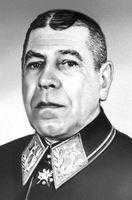Boris Shaposhnikov
| Boris Mikhailovitch Shaposhnikov | |
|---|---|
 Marshal of the Soviet Union Boris Shaposhnikov. | |
| Born |
October 2, 1882 Zlatoust, Ufa Governorate, Russian Empire |
| Died |
March 26, 1945 (aged 62) Moscow, Soviet Union |
| Buried at | Kremlin Wall Necropolis |
| Allegiance |
|
| Years of service | 1901–1945 |
| Rank |
Colonel (Imperial Army) Marshal of the Soviet Union (Red Army) |
| Commands held |
Leningrad Military District Moscow Military District Chief of the General Staff Volga Military District |
| Battles/wars |
World War I Russian Civil War World War II |
| Other work | Mozg Armii (The Brain of the Army), 1929. |
Boris Mikhailovitch Shaposhnikov (Russian: Бори́с Миха́йлович Ша́пошников) (October 2 [O.S. September 20] 1882 – March 26, 1945) was a Soviet military commander.
Biography
Shaposhnikov was born at Zlatoust, near Chelyabinsk in the Urals. He was of Orenburg Cossack origin.[1] He joined the army of the Russian Empire in 1901 and graduated from the Nicholas General Staff Academy in 1910, reaching the rank of colonel in the Caucasus Grenadiers division during World War I. In 1917, unusually for an officer of his rank, he supported the Russian Revolution and in 1918 joined the Red Army.
Shaposhnikov was one of the few Red Army commanders with formal military training, and in 1921 he joined the Army's General Staff, where he served until 1925, when he was appointed commander of the Leningrad military region. From 1928 to 1932 he commanded the Moscow military region, then the Privolzhsk military region. In 1932 he was appointed commandant of the Red Army's Frunze Military Academy, then in 1935 returned to the command of the Leningrad region. In 1937 he was appointed Chief of the General Staff, in succession to Alexander Ilyich Yegorov, a victim of the Case of Trotskyist Anti-Soviet Military Organization secret trial, Joseph Stalin's Great Purge of the Red Army. In 1940 he was appointed a Marshal of the Soviet Union.
Despite his background as a Tsarist officer, Shaposhnikov won the respect and trust of Stalin. Ironically his status as a professional officer—he did not join the Communist Party until 1930—may have helped him avoid Stalin's suspicions. The price he paid for his survival during the purges was collaboration in the destruction of Tukhachevsky and many other colleagues. Stalin's admiration was shown by the fact that he always kept a copy of Shaposhnikov's most important work, Mozg Armii (Мозг армии, "The Brain of the Army") (1929), on his desk[citation needed].
Fortunately for the Soviet Union, Shaposhnikov had a fine military mind and high administrative skills[citation needed]. He combined these talents with his position in Stalin's confidence to rebuild the Red Army leadership after the purges. He obtained the release from Gulag for 4 000 officers deemed as necessary for this operation. Mozg Armii was for decades required reading for every Soviet officer[citation needed]. In 1939 Stalin accepted Shaposhnikov's plan for a rapid build up of the Red Army's strength. Although the plan was not completed before the German invasion of June 1941, it was sufficiently advanced to save the Soviet Union from complete disaster[citation needed].
Shaposhnikov planned the invasion of Finland in 1940, but the commander Kliment Voroshilov thought the plan was too pessimistic and chose to ignore it[citation needed]. The Winter War did not become the success the Soviet side had hoped, and Shaposhnikov resigned as Chief of the General Staff in August 1940, officially due to ill-health. At the time of the German invasion, he was reinstated as Chief of the General Staff (until November 1942) and also became Deputy People's Commissar for Defence, the post he held until his career was cut short by ill-health in 1943. He held the position of commandant of the Voroshilov Military Academy until his death in 1945.
Honours and awards
- This article incorporates information from the equivalent article on the Russian Wikipedia.
- Russian Empire
- Order of St. Anna, 4th class (26 October 1914), 3rd class with Swords and Bow (1915), 2nd class with Swords (1 November 1916)
- Order of St. Vladimir, 4th class with Swords and Bow (2 November 1914)
- Order of Saint Stanislaus, 3rd class with Swords and Bow (22 July 1916)
- Soviet Union
- Three Orders of Lenin (31 December 1939, 3 October 1942, 21 February 1945)
- Order of the Red Banner, twice (14 October 1921, 3 November 1944)
- Order of Suvorov, 1st class (22 February 1944)
- Order of the Red Star, twice (15 January 1934, 22 February 1938)
- Jubilee Medal "XX Years of the Workers' and Peasants' Red Army" (22 February 1938)
- Medal "For the Defence of Moscow" (1 May 1944)
See also
- Russian destroyer Marshal Shaposhnikov (BPK 543)
References
- ↑ A. Shishov. 100 great Cossacks http://fisechko.ru/100vel/kazakov/91.html
| Military offices | ||
|---|---|---|
| Preceded by Mikhail Tukhachevsky |
Chief of the Staff of the Red Army 1928 - 1931 |
Succeeded by Alexander Yegorov |
| Preceded by Alexander Yegorov |
Chief of the Staff of the Red Army 1937 - 1940 |
Succeeded by Kirill Meretskov |
| Preceded by Georgy Zhukov |
Chief of the Staff of the Red Army 1941 - 1942 |
Succeeded by Aleksandr Vasilevsky |
|